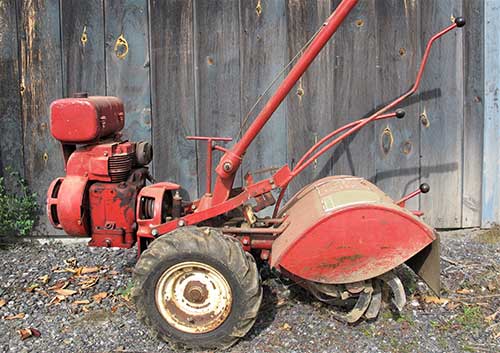 |
| One treatment in our study of the effects of tillage on soil health used a rototiller for cultivation. |
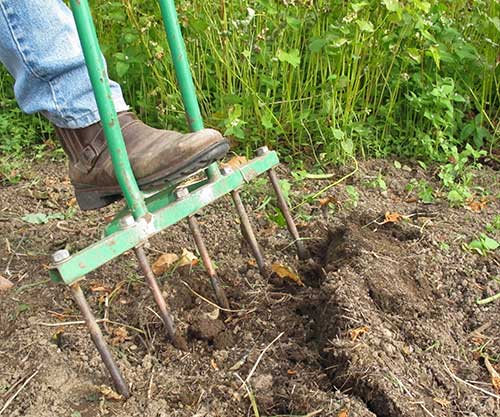 |
| Another treatment used a broadfork. |
By Will Brinton
Soil tillage is an increasingly important topic of discussion among agriculturists and poses new challenges for organic practices. At a soil health event in Aroostook County in 2014, Ray Archuleta, conservation agronomist with the Natural Resources Conservation Service (now retired) and critic of tillage in organic farming, described the dilemma as follows: “Think of tillage as waking up the soil critters whereby they eat all the organic matter.”
Organic methods are essentially tillage and rotation-based strategies. Peterson (1998) describes soil cultivation as stimulating soil carbon (C) loss and thereby accelerating oxidation of soil C by microbial activity. Jackson (2003) addresses short-term changes due to “tillage perturbation,” suggesting that impacts on soil quality proceed rapidly. One current hypothesis is that reduced soil disturbance (no-till) slows decomposition of soil carbon, which increases soil C sequestration.
Field Plot Study
We were interested in determining by multiple indicators whether we could observe changes in soils in a single season when comparing organic to no-till. To do this we established a field plot study with four management types and three replicates over an entire season. We rototilled or broadforked weekly for organic weed control, and we compared these treatments to no-till and no-till fallow (herbicide-treated).
Table 1 shows treatments triplicated in 5-by-5-foot plots into winter wheat. The soil series is Paxton sandy loam, taxonomically Oxyaquic Dystrudept, soil order Inceptisol. The initial soil organic matter was 7.6 percent, and total C was 3.799 percent ± 0.226. We thought that with a high starting OM content, it was more likely that changes attributed to management could be readily distinguished.
Table 1. Layout of Treatments Used in Plot Study
| (BNT) Bare No Till | (NT) No-Till | Hand-Till (HT) | Rototill (RT) |
| Glyphosate at day 1 and day 70; no other management (bare, fallow); weeds re-initiated at day 60, requiring added glyphosate | No soil disturbance management; full crop | Hand till weekly by broadfork; full crop | Rototilling with Troy-Built Horse® weekly; little or no crop or weeds |
Comparing systems is complicated since emergent or collateral effects due to treatments may confound observations. For example, intense rototilling (the tiller blades rotate at between 146 and 220 rpm) eventually terminated the entire crop and its weeds, as did herbicide fallow; however, broadforking only slightly disturbed the crop while reducing weeds, and no-till maintained the crop intact with some weeds. Normally, a tiller would be used in-between rows (such as in garden beds or row corn) and not in winter wheat, but we chose to start with a crop that had full canopy cover at first.
We employed several metrics of soil quality to be measured weekly, including soil temperature and lab analyses of soil to 15 cm depth. We disturbed soil minimally when sampling to avoid artifact effects on soil biology. We employed loss on ignition (LOI) for combustible organic matter and total organic carbon (TOC) for total carbon. For microbial activity we measured fresh soils immediately after sampling. Respiration tests were by Solvita protocol and were corroborated by infrared gas analysis. We evaluated water-stable aggregates by wet sieving, and N-mineralization as accumulated nitrate.
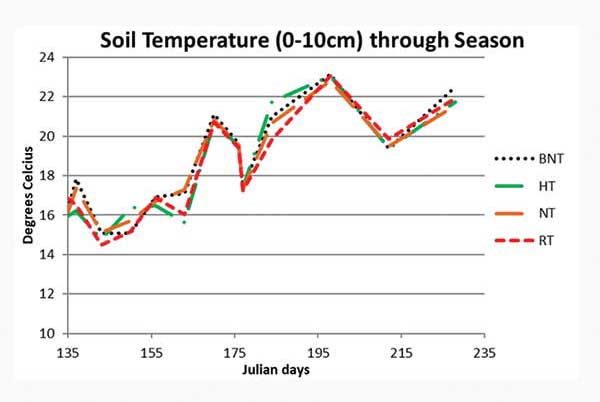 |
|
|
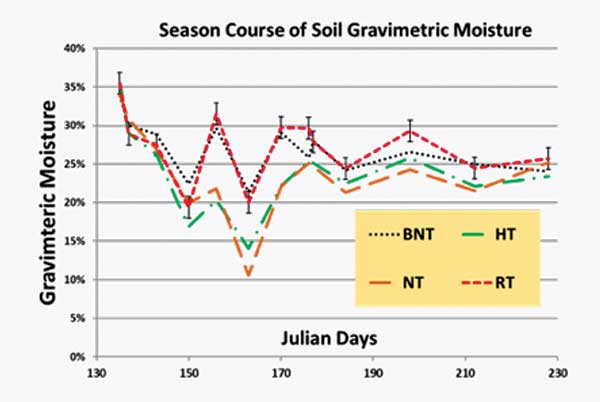 |
|
|
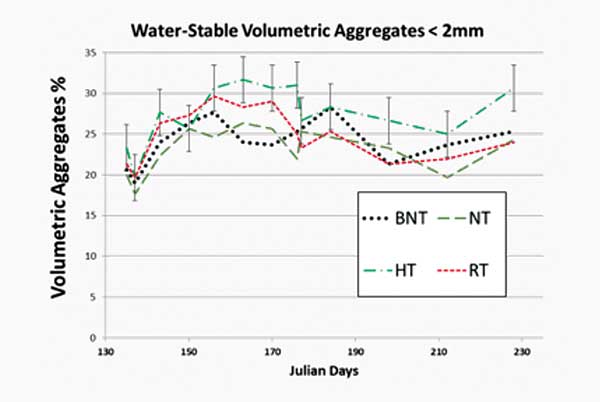 |
|
|
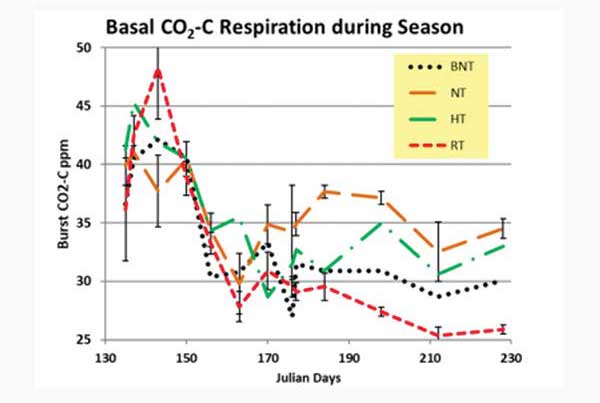 |
|
|
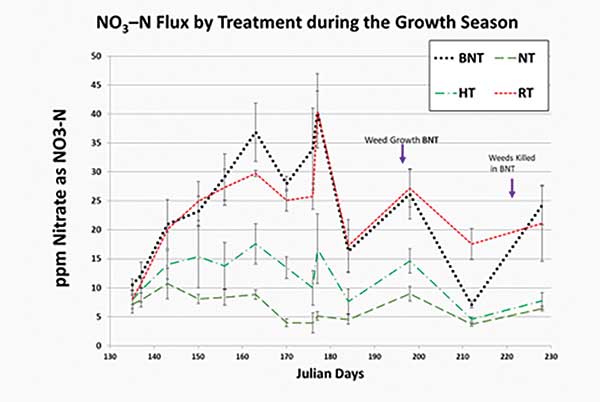 |
|
|
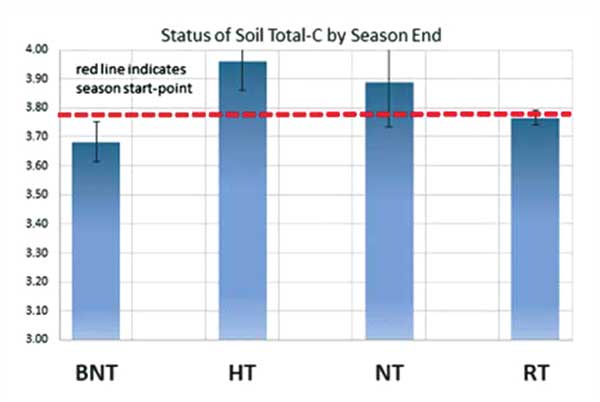 |
Results
Tillage did not affect soil temperature, which mirrored mean daily air temperature with a slow steady rise of 8°C from 15 to 23°C during the season (Figure 1). Temperature is known to control microbial metabolic rates, and a doubling of activity is assumed for a 10°C change. Had tillage or no plant cover in the fallow plots triggered an increase in soil warmth, then this alone would support the claim of increased loss of carbon. Surface plant and residue cover interact with soil thermal conductivity, which tillage affects, making this a tricky and sometimes inconclusive determination. Incidentally, tilling soil may introduce warmer air, but it strongly disrupts thermal conductivity and therefore soil may ultimately become cooler.
Soil moisture content (Figure 2) indicated that the rototill (RT) and bare no-till (BNT) plots were highest in moisture throughout the season compared to no-till (NT) and broadfork (HT) plots. This effect is most likely attributable to water uptake and transpiration by plants, not to tillage. (The short, vertical “handle-bars” in this and some other figures are the standard error (SE) of measurement.)
Water-stable aggregates (Figure 3), the small soil particles that resist water dispersion, increased by midseason, with broadfork (HT) being the highest. Despite weekly tillage, rototilled plots were not lower than all other treatments except hand-tilling. We therefore think that micro-aggregates, which are so important in soils, are simply too small to be affected by this form of coarse tillage.
CO2 respiration (Figure 4) by microbes declined during the season, most likely due to soil dryness in 2018 overriding any effects of increased warmth. Opposite to what we expected, the rototilled plots were significantly lower at the end of the year in microbial CO2 respiration. This contradicts the theory that rototilling breaks up protected structures, triggering more oxidation. We saw consistently higher respiration in NT and HT plots, which are virtually opposite management strategies. Apparently, the presence of plants rather than soil tillage is controlling the feeding of soil and release of C as CO2.
Discussion
This study was conducted with 14 weekly evaluations of four replicated treatments using multiple test indicators. We made approximately 1,200 individual quantitative observations, so we believe the study is robust.
Results confirm that several practices have observable short-term effects, as the literature suggests. Examples are CO2 respiration, N-mineralization and water-stable aggregates. Plots with higher CO2 rates were associated with treatments in which more plants were present; coincidentally, these were the no-till and broadfork systems. Intense rototilling significantly reduced CO2 release as did BNT (herbicide plots), which had little or no plants surviving.
Nitrate tests (Figure 5) enabled several insights into interactions. Rototilled plots were nearly identical to herbicide-fallow, which rose steadily to a high of 40 ppm (80 lbs./acre N) by midseason and then declined (no fertilization had been employed). This shows that these soils were metabolizing carbon and releasing organic nitrogen equally. Low levels of nitrate in the broadfork (HT) and no-till plots indicate plant scavenging. NT plots were the best in this regard, probably because more plants were present. As soon as weeds commenced regrowth in fallow plots after the herbicide biodegraded, nitrate declined but reversed its trend after weeds were again terminated. Killing plants apparently causes a “dump” of soluble nutrients back into the soil (perhaps also true for natural termination of cover crops).
Overall, we observed no functional difference in soil health traits comparing organic tillage to herbicides in the course of the season. Apparently, organic methods with tillage in this fashion are not likely to be disadvantageous to soil quality compared to no-till, contrary to what is popularly supposed, and may be significantly better than fallow. This does not mean this observation will be universally true. Our plots had quality soil to begin with. This fact combined with favorable soil type and plant composition could influence behavior differently in differing regions.
The carbon sequestration picture that emerged was inconclusive (see figure 6). Spatial variability of TOC across the field plots apparently was large enough that statistical differentiation of expected very small seasonal effects was limited (the rototilled plots had the smallest error of measurement). BNT showed no change in carbon while HT gave the largest increase, more than NT (both had plants present). Weekly rototilling showed no change compared to the starting baseline. This indicates at the very least that to draw solid conclusions regarding soil carbon changes due to tillage would require more years of studies and greater sampling volume than triplicates tests.
Synopsis
The emphasis in popular literature that tillage by organic practices necessarily reduces soil carbon or damages soil health is probably not true for northern temperate regions of this soil type. Instead, plants appear to be the key to sustaining and increasing test qualities associated with soil health. Management systems that reduce plant population (e.g., tillage or herbicides) are likely to reduce soil health. Conversely systems that improve crop growth (NT and broadforking) may improve soil health. This leads logically to an associated conclusion that weedy organic systems, despite tillage, most likely have the healthiest soils. It also raises important questions about the nature of so-called protected organic matter, an increasingly popular theme for carbon sequestration.
Acknowledgement
I would like to thank University of Maine graduate Jeremiah Vallotton (now a doctoral student at Memorial University of Newfoundland) for pushing through this project determinedly with such an intense sampling regimen and lab analyses all conducted on time.
About the author: Will Brinton is the founder and president of Woods End Laboratories in Mount Vernon, Maine (https://woodsend.com). A poster version of this paper was presented at the Annual Soil Science Society meeting “Soils Across Latitudes” held in San Diego, Jan. 6-9, 2019, and at the Soil Health Institute symposium “Soil Health: A Global Imperative” held in Sacramento, July 16-18, 2019.
